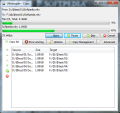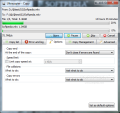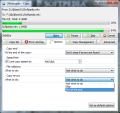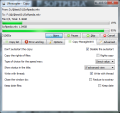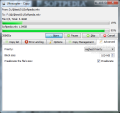Windows is known for its rigid file copying or moving procedure. Once you get the process started you cannot pause it or limit its speed. Third party tools like Ultracopier correct this problem by offering complete services when copying files or moving them to a different location. It also attempts to outrun the default file copy/move engine in the operating system.
Ultracopier is absolutely free of charge and because it is based on Qt is can be used on all three major platforms: Windows, Linux and Mac. As soon as you put it on the system and it is started it will automatically take over any file copying/moving endeavors, but it can also be set to sit in the system tray and put its features at work only when you want it to, leaving all the copy tasks to Windows.
The only interface available in the program is the “Options” dialog which features settings for limiting copy speed, instructing the program what to do in case of file collisions or copy errors as well as the priority of the process or the copied block size.
During the file transfer process Ultracopier shows only a minimal amount of detail by default. This includes just the destination, the original location of the data and the number of files that need to be copied or moved. A progress bar is also present, but alone this isn’t much estimation for completing the job.
For more information on the current job you can expand it and view the items currently dealt with, progress is expressed in percentage and you will also be offered the transfer speed. More importantly, you will be able to change the priority of the files by moving them higher in the list.
Ultracopier also lets you add more items (both files and folders) to the list and set different destination paths. Each entry is processed in the order it has been added.
One of the best parts in the application is that it can continue the file copying process even if it encounters errors. These are all saved in the “Error and log” tab of the extended transfer menu.
Configuration options of the program can be changed during the transfer job with no problem and will take effect on the spot, without having to restart Ultracopier. However, for more settings which also affect the interface (language, style) and the way the software starts you have to bring them up from the right click menu of the system tray icon.
Enabling or disabling Ultracopier can be done from the “Starting” tab of the configuration panel, but an easier way to do it is simply double clicking the system tray icon. The color of the icon (red for enabled, blue for disabled) is the tell sign for the application being on or off.
During our tests we bumped into a nasty glitch in Ultracopier, which caused explorer.exe to crash. Every time we closed the application, or simply disable its services, Windows Explorer would crash.
As far as achieving faster file copying/moving speeds is concerned, our tests showed that Windows Explorer completes the operation at a quicker pace. First we used a 278MB directory with 3905 subfolders and 15625 files. Ultracopier needed more than four minutes to complete the task while Windows finished in 2’07’’.
Ultracopier would have finished faster if it had indexed the data while starting the copying process. Timing it at the exact moment of the beginning of the copying process it finished 19 seconds ahead Microsoft’s tool.
Another test was conducted with a single large file of 1.09GB. The two contenders were neck to neck in the race, but in the end Ultracopier managed to come on top, averaging 24 seconds and 25 milliseconds, while Windows Explorer lagged about 1 second behind, with an average of 25 seconds and 5 milliseconds.
For the third test we prepared five folders, each containing the 1.09GB file used earlier. The averages were quite clear on this one (2’36’’ to 2’44’’), with Windows Explorer being faster by 8 seconds than Ultracopier. Just for kicks we made the test once with TeraCopy, which recorded the bet time, 2’30’’.
During all our tests Ultracopier was configured to run with the highest priority from the “Advanced” menu of the program. This, however, was not reflected in resource usage as the program maintained an average of 10% of CPU usage while the memory required would be about 24MB. Also, when we checked the process priority, Task Manager would show it set to “normal”.
Ultracopier is at an early stage of development as we witnessed ourselves through the explorer.exe crashes. But there are other strange things happening as well, like the fact that on several occasions the transfer process would start but no progress was displayed. Also, we only caught a glimpse of time estimation for completing the task as it would not always show on screen.
The application can be switched on and off according to your preferences straight from the system tray icon.
The Good
The Bad
The Good
Ultracopier managed to move faster than Windows Explorer in one of our tests, but when it came to heavy folders with large files its average time was lower than the default tool in Windows.
A major downer is the fact that it causes explorer.exe to crash. On the bright side, it offers incredible control over file and folder transfers, which compensates the eventual lack of speed in some cases.
 14 DAY TRIAL //
14 DAY TRIAL // 